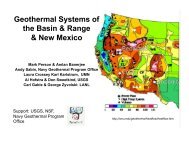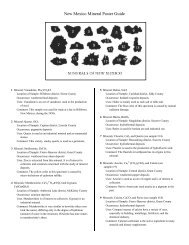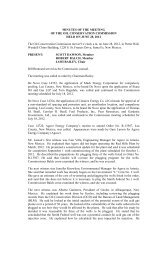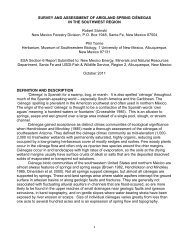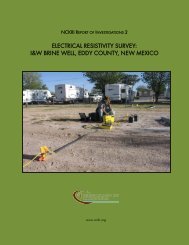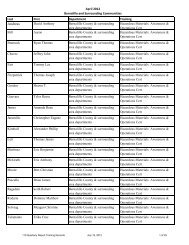Annual Report 3 - New Mexico - Energy, Minerals and Natural ...
Annual Report 3 - New Mexico - Energy, Minerals and Natural ...
Annual Report 3 - New Mexico - Energy, Minerals and Natural ...
You also want an ePaper? Increase the reach of your titles
YUMPU automatically turns print PDFs into web optimized ePapers that Google loves.
CERB program is jointly administered by ECMD <strong>and</strong> the <strong>New</strong> <strong>Mexico</strong> Finance Authority (NMFA). ECMD is<br />
responsible for providing energy audit funding, reviewing the projects, calculating the estimated energy cost savings<br />
<strong>and</strong> making certification to the NMFA for sale of revenue bonds. Currently, energy audits are under review for the<br />
<strong>New</strong> <strong>Mexico</strong> Department of Transportation for installation of a large photovoltaic array at its Santa Fe location <strong>and</strong><br />
for nine school districts located in eastern <strong>New</strong> <strong>Mexico</strong>. The energy audits’ review will ensure that the reports provide<br />
sufficiently-detailed information for certification to NMFA.<br />
Public Facility <strong>Energy</strong> Efficiency <strong>and</strong> Water Conservation Act [NMSA 1978, § 6-23]: Permits governmental<br />
units such as public schools, universities, municipalities <strong>and</strong> state agencies to enter into long-term installment<br />
payment contracts <strong>and</strong> lease-purchase agreements of up to 25 years for the evaluation, recommendation, purchase<br />
<strong>and</strong> installation of energy efficiency, renewable energy <strong>and</strong> water conservation measures. ECMD reviews the<br />
energy studies developed for these projects to determine if the contractor is qualified <strong>and</strong> if the energy conservation<br />
measures proposed are accurately estimated <strong>and</strong> reasonable. Since the law was passed, public schools, local<br />
governments <strong>and</strong> universities have invested $30 million to realize guaranteed savings of $43 million in utility costs.<br />
These cost savings were generated by reductions of 29 million kWh of electricity <strong>and</strong> 864,000 therms of natural gas.<br />
In addition, millions of gallons of water are saved annually by the reduced energy usage.<br />
Efficient Use of <strong>Energy</strong> Act (EUEA) [NMSA 1978, § 62-17]: Requires that utilities “acquire” energy efficiency<br />
into their resource mix. The EUEA requires both electric <strong>and</strong> natural gas utilities to “acquire all cost-effective <strong>and</strong><br />
achievable energy efficiency.” “Cost effective” essentially means funding <strong>and</strong> implementing all energy efficiency<br />
measures that are less expensive than the alternative of building <strong>and</strong> operating a power plant. As a minimum,<br />
however, the EUEA states that the electric utilities’ requirement “…shall not be less than savings of 5 percent of 2005<br />
retail… sales …in calendar year 2014 <strong>and</strong> 10 percent in 2020.” Utilities are required to file energy efficiency plans<br />
annually.<br />
The cost-effective energy efficiency approach embodied in the EUEA is also referred to as “decoupling.” <strong>Energy</strong><br />
efficiency programs are to be decoupled from energy retail sales; utilities may request rate adjustments to pay for<br />
the programs. <strong>Energy</strong> efficiency measures cost approximately two to five cents per kWh to implement, whereas new<br />
electric power plants are expected to run in excess of 10 cents per kWh. Thus, the long-term savings to the customers<br />
of incorporating energy efficiency measures <strong>and</strong> delaying the need to build <strong>and</strong> operate a new power plant can be<br />
enormous.<br />
Public Regulation Commission (PRC) Activities: EMNRD-ECMD is heavily involved in PRC proceedings,<br />
primarily as they relate to the Renewable <strong>Energy</strong> Act <strong>and</strong> the above-described EUEA. <strong>New</strong> <strong>Mexico</strong> has also made<br />
a commitment to DOE to achieve decoupling of efficiency from rates in exchange for receiving $31.8 million of<br />
ARRA funding. Under both statutes, the state’s three IOUs, Public Service Company of <strong>New</strong> <strong>Mexico</strong> (PNM), El<br />
Paso Electric Company, <strong>and</strong> Southwestern Public Service Company (SPS), are required to make annual program<br />
plan filings to the PRC. Since the PRC is quasi-adjudicative in nature, these filings are addressed via a quasi-judicial<br />
process involving a hearing examiner, formal testimony <strong>and</strong> rebuttal. In addition, utilities’ periodic rate case filings<br />
often have renewable energy <strong>and</strong>/or energy efficiency provisions in them that EMNRD-ECMD addresses in its<br />
participation.<br />
ANNUAL REPORT 2010<br />
37




